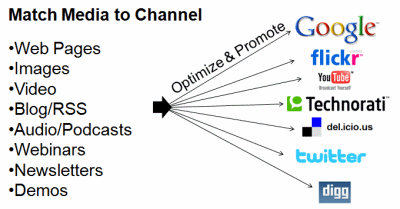
The search marketing industry is rich with acronyms: SEO, SEM, PPC, ROI, SERPs (even LMAO) as well as buzz phrases such as “search engine optimization” and “social media optimization”. Do we really need another?
One of the few things to be counted on in search marketing is that there will be change. That change comes in many forms including search engine algorithm changes (albeit more gradual than large, single events), changes in consumer search behavior and the introduction of evolving search channels such as social search and the semantic web.
With these changes come opportunities whether they are consumer, search engine or marketing driven. “Digital Asset Optimization“ refers to the practice of taking inventory of a company’s marketable, digital assets and implementing a process for keyword optimization and promotion to relevant channels.
How is “DAO” different than “SEO”? Search engine optimization typically focuses on the optimization of a company web site to improve discovery and indexing by search engine spiders as well as organizing content, keyword placement and links to give standard search engines the signals they need to rank pages in favor of the company.
It’s not enough to retain a competitive advantage with search driven online marketing programs though a singular focus on web page optimization. The increasing popularity of media specific search engines and content sharing web sites as well as the advent of Universal search creates a matrix of promotion opportunities.
Consumer search and information consumption trends towards video, interactive and content sharing presents a different set of expectations within the search experience. Content creators and marketers are challenged to meet those demands through more robust asset optimization efforts.
With combined search results, the practice of querying distinct databases such as image, video, blog, news and products and then incorporating them into standard search results presents the most significant change in search engine results page user interface in at least 5 years. The same rules for web page SEO do not apply when optimizing video, images, news or blog posts to show up in Google Universal search results.
Demand for a variety of content types is on the rise.
Search engines want companies to publish more content because it provides them with more inventory against which they can run advertisements. Consumers want more content in varied formats to make smarter decisions about purchase. Internet marketing agencies want their clients to publish more content in order to capture more search engine traffic and online sales.
If an asset can be searched on, it can be optimized. Identifying all the promotable, digital assets available to a web site gives companies that are not content-rich the additional resources needed to be competitive in today’s search environment.
Each web site has digital assets including web pages, images and increasingly video, podcasts, blogs and RSS feeds. A digital asset optimization strategy identifies content in all its forms, formats and intentions and applies filters to qualify what is most promotable. Keyword mapping to each promotable asset (both on and offsite) along with a content promotion plan helps organize and keep accountable the digital asset optimization effort.
Web sites that do produce substantial varieties and quantities of content types gain even more advantage when leveraging digital assets. The challenge is organizing a complex process that extends far beyond optimizing web pages to content produced in various areas of an organization. Coordinating SEO and asset optimization between the web content team, brand managers, public relations, legal, marketing and even different business units/departments can be a real barrier to entry without the expertise and insight that an experienced in-house marketer or internet marketing agency can offer.
It can be argued that the notion of optimizing digital assets is simply an extension of the search engine optimization consulting services agencies like TopRank provide in the same way optimizing social media has evolved into a distinct marketing channel. There’s no doubt that SEO is constantly changing. Paying attention to new search channels, consumer demand for rich media and the need for content types against which to advertise, is a real opportunity for those marketers ready to take fundamental SEO to the next level.
[A shorter version of this post was published on DMNews SearchBuzz]


